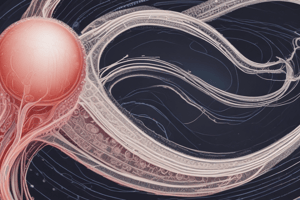Podcast
Questions and Answers
Where does spermatogenesis occur?
Where does spermatogenesis occur?
- Testes (correct)
- Epididymis
- Seminal vesicles
- Prostate gland
What do male and female gametes arise from?
What do male and female gametes arise from?
- Red blood cells
- Muscle cells
- Primordial germ cells (correct)
- Somatic cells
What is the result of oogenesis?
What is the result of oogenesis?
- Formation of haploid spermatozoa
- Formation of diploid ova
- Formation of small, motile spermatozoa
- Formation of large, non-motile ova (correct)
What do primordial germ cells become in males and females?
What do primordial germ cells become in males and females?
What is the function of the blood-testis barrier?
What is the function of the blood-testis barrier?
Which cells are responsible for supporting the developing spermatozoa?
Which cells are responsible for supporting the developing spermatozoa?
Why is it important for the blood-testis barrier to prevent the immune system from recognizing the sperm as foreign?
Why is it important for the blood-testis barrier to prevent the immune system from recognizing the sperm as foreign?
Flashcards are hidden until you start studying
Study Notes
Gametogenesis
- Spermatogenesis occurs in the seminiferous tubules of the testes.
- Male and female gametes (spermatozoa and ova) arise from primordial germ cells.
- The result of oogenesis is the formation of ova (egg cells).
Primordial Germ Cells
- In males, primordial germ cells become spermatogonia, which differentiate into spermatozoa.
- In females, primordial germ cells become oogonia, which differentiate into ova.
Blood-Testis Barrier
- The blood-testis barrier, also known as the Sertoli cell barrier, is a physical barrier between the seminiferous tubules and the bloodstream.
- The function of the blood-testis barrier is to isolate the developing spermatozoa from the immune system and prevent an autoimmune response.
- Sertoli cells are responsible for supporting the developing spermatozoa and forming the blood-testis barrier.
Immune System and Sperm
- If the immune system recognizes sperm as foreign, it would mount an immune response, damaging the sperm and making fertilization impossible.
- The blood-testis barrier prevents the immune system from recognizing the sperm as foreign, allowing fertility to occur.
Studying That Suits You
Use AI to generate personalized quizzes and flashcards to suit your learning preferences.




